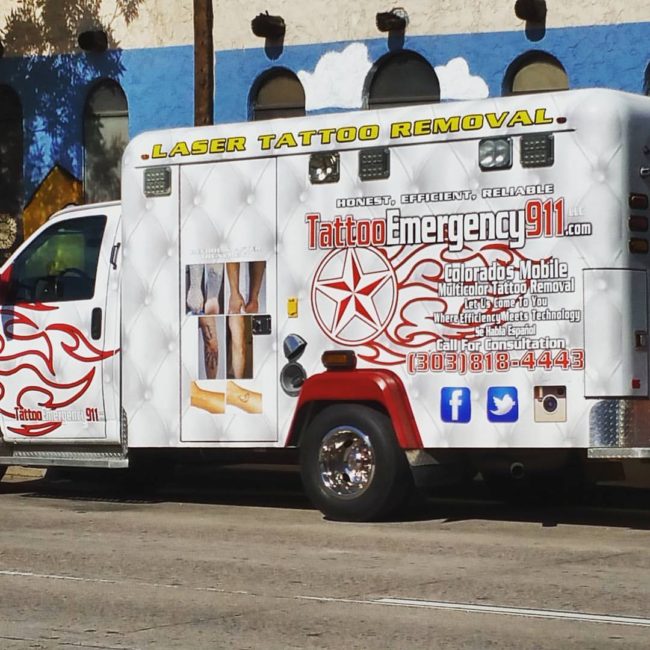 Jesus Bujanda has created TattooEmergency911, a mobile tattoo removal business that removes unwanted tattoos from juvenile offenders. It’s a model that others may wish to follow, and those who do may eventually be able to purchase a mobile clinic from him.
Jesus Bujanda has created TattooEmergency911, a mobile tattoo removal business that removes unwanted tattoos from juvenile offenders. It’s a model that others may wish to follow, and those who do may eventually be able to purchase a mobile clinic from him.
Bujanda, a Denver area resident and automotive technology high school teacher, was inspired by a nephew who had recently been released from prison and had his tattoos removed.
They had discussed the idea of starting a tattoo removal business at a family Thanksgiving dinner. By New Year’s, Bujanda’s wife had come up with the idea of using an ambulance which would be turned into a clinic and his 8-year-old daughter had come up with the name. Six months later he was in school learning how to be a laser tattoo removal technician.
That was about 18 months ago. Bujanda bought an ambulance, outfitted it so he could perform tattoo removal procedures and began searching for clients. He eventually got a contract with an agency that works with the state of Colorado and now does tattoo removals at three prisons and four transitional living facilities that cater to juvenile offenders. And it’s the youth he’s determined to help.
“A lot of kids make a lot of horrible choices,” he said. “I’ve been working with this population for the last 20 years, and I feel like I’ve kind of found my niche.”
Because he’s still teaching full time, Bujanda does treatments in the evenings and on weekends.
“I have the majority of the state for juveniles,” he says. “As these kids get out, part of their parole is to take their tattoos off. They’re trying to find a job, but they can’t find a job with tattoos on their face. If they do the tattoo removal six months to a year ahead of time, it’s better.” And that’s what Bujanda is trying to do – take off tattoos before they leave prison.
Although he would like to “retire” to the tattoo removal business full time, that may take a while. His wife has opened a brick-and-mortar location that provides aesthetic and laser services, while he continues to teach.
“I don’t have enough clients to retire yet,” Bujanda says, but is hoping to get them by expanding his business to California. He’s establishing residency in Bakersfield and working with the Small Business Development Center there to bring his mobile tattoo services to the area.
He’s also taking classes on how to create proposals for federal funding and would like to work within the federal prison system as well.
In addition, Bujanda plans to create mobile tattoo units as part of his business and is already communicating with someone in Great Britain who is interested in having one designed.
“I’ll have all the software put in, the lasers installed and the rig completely ready to go,” he says.
“It is very difficult. I almost didn’t survive my first year. If you had to pay to build a rig like mine it would be super expensive. I was able to do 95% of the work myself.”
Having him provide the vehicle could save someone a lot of time, money and stress, Bujanda says. And it would be fully outfitted and ready to use.
For those who may want to put together their own rig, however, Bujanda says it will take a tremendous amount of research. And then things don’t always work out.
It’s possible to buy a retired ambulance with relatively low mileage. “Some ambulances from rural areas aren’t used that much, so they might retire them at 30,000 miles or up to 100,000 miles, and they’re very well maintained,” he says.
You may find a dealer for one of these used ambulances by searching online for “used ambulance dealers.” There are also companies that will design and produce custom-ordered vehicles for medical uses. One mobile tattoo unit used Quality Vans of Tempe, Ariz., for example. Other similarly specialty vehicles producers can be located by searching the member’s directory of NTEA, The Association for the Work Truck Industry.
And nonprofits might want to team up with their county health department or other local medical organization, if it is one of the clinics that operates a mobile health program. There are an estimated 2,000 of these programs across the U.S. Mobile Health Map offers details on 700 of them.
Meanwhile, when it comes to equipment Bujanda recommends buying a laser device from a company that has a technician in town, or at least close by, if possible. That way if something goes wrong you won’t have to fly someone in to fix it.
The interior was one of his biggest challenges, mainly because the man who he hired to do it got sick, so Bujanda had to learn how to do the work, including the electricity, himself.
And he purchased the wrong flooring. “It looked really nice when I first put it in, but what looks good in a doctor’s office takes a lot of maintenance,” he says.
But in the end, he has his rig. “You really have to sit down and understand what you’re doing. It’s all trial and error.”

